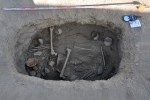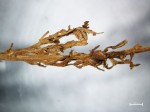 An ancient grave unearthed in Jiayi cemetery in China’s Turpan Basin contains the remains of man covered in cannabis plants. Radiocarbon dating found that the man was buried between 2,400 to 2,800 years ago. The remains of a man about 35 years of age at the time of his death were laid to rest on a wooden bed with his head on a reed pillow. Thirteen female cannabis plants, all of them close to three feet long, were laid diagonally on the man’s body. The roots placed below his pelvis, the tops reaching his chin and going up the left side of his face.
An ancient grave unearthed in Jiayi cemetery in China’s Turpan Basin contains the remains of man covered in cannabis plants. Radiocarbon dating found that the man was buried between 2,400 to 2,800 years ago. The remains of a man about 35 years of age at the time of his death were laid to rest on a wooden bed with his head on a reed pillow. Thirteen female cannabis plants, all of them close to three feet long, were laid diagonally on the man’s body. The roots placed below his pelvis, the tops reaching his chin and going up the left side of his face.
 About 240 graves have been excavated in Jiayi cemetery. Archaeologists believe it was a burial ground of the Subeixi culture which lived in the oasis between 3,000 and 2,000 years ago. Cannabis has been found in other graves in the Turpan Basin before, most notably a solid two pounds of seeds and powdered leaves found in a shaman’s burial in 2008, have been found in graves from this period before, but this is the first time entire plants have survived and the first time they’ve been found in a shroud configuration.
About 240 graves have been excavated in Jiayi cemetery. Archaeologists believe it was a burial ground of the Subeixi culture which lived in the oasis between 3,000 and 2,000 years ago. Cannabis has been found in other graves in the Turpan Basin before, most notably a solid two pounds of seeds and powdered leaves found in a shaman’s burial in 2008, have been found in graves from this period before, but this is the first time entire plants have survived and the first time they’ve been found in a shroud configuration.
The plants are in excellent condition, good enough to answer key questions about how cannabis was grown and used for funerary purposes in the region.
Since previous cannabis finds in Turpan burials consisted only of plant parts, it has been difficult for researchers to determine whether the plant was grown locally or obtained through trade with neighboring regions.
The plants in the Jiayi burial, however, were found lying flat on the man’s body, leading archaeologists to conclude that the cannabis had been fresh—and therefore local—when it was harvested for the burial.
In addition, while nearly all of the flowering heads of the 13 female plants had been cut off before they were placed on the body, a few that remained were nearly ripe and contained some immature fruit, suggesting that the plants were collected—and that the burial occurred—in late summer.
 The surviving flowering heads also provide clues to the role of cannabis in the Turpan cultures. The fibrous plants might have been valued for their usability in textile and rope-making, for example, rather than inhaled or eaten to alter consciousness. No hemp textiles or artifacts have been found, however, and the buds found in the Jiayi grave are rich in “hairs” THC-heavy hairs, suggesting that they were grown at least in part for their psychoactive properties.
The surviving flowering heads also provide clues to the role of cannabis in the Turpan cultures. The fibrous plants might have been valued for their usability in textile and rope-making, for example, rather than inhaled or eaten to alter consciousness. No hemp textiles or artifacts have been found, however, and the buds found in the Jiayi grave are rich in “hairs” THC-heavy hairs, suggesting that they were grown at least in part for their psychoactive properties.
The study of the cannabis in the Jiayi grave has been published in the journal Economic Botany and can be read here for a fee (unless you have an institutional login).
Histories from 2600 years ago in Central Asia (Ht. Bk IV, 74/75) – btw, similar ‘steam baths’ are still applied in e.g. Namibia among the Himba people in the Kunene region, where water is scarce:
————-
74. Now they [Skyths] have hemp growing in their land, which is very like flax except in thickness and in height, for in these respects the hemp is much superior. This grows both, by itself and with cultivation; and from it the Thracians even make garments, which are very like those made of flaxen thread, so that he who was not specially conversant with it would not be able to decide whether the garments were of flax or of hemp; and he who had not before seen stuff woven of hemp would suppose that the garment was made of flax.
Ἔστι δέ σφι κάνναβις φυομένη ἐν τῇ χώρῃ πλὴν παχύτητος καὶ μεγάθεος τῷ λίνῳ ἐμφερεστάτη· ταύτῃ δὲ πολλῷ ὑπερφέρει ἡ κάνναβις. αὕτη καὶ αὐτομάτη καὶ σπειρομένη φύεται, καὶ ἐξ αὐτῆς Θρήικες μὲν καὶ εἵματα ποιεῦνται τοῖσι λινέοισι ὁμοιότατα· οὐδ᾽ ἄν, ὅστις μὴ κάρτα τρίβων εἴη αὐτῆς, διαγνοίη λίνου ἢ καννάβιος ἐστί· ὃς δὲ μὴ εἶδε κω τὴν κανναβίδα, λίνεον δοκήσει εἶναι τὸ εἷμα.
75. The Scythians then take the seed of this hemp and creep under the felt coverings, and then they throw the seed upon the stones which have been heated red-hot: and it burns like incense and produces a vapour so think that no vapour-bath in Hellas would surpass it: and the Scythians being delighted with the vapour-bath howl like wolves. This is to them instead of washing, for in fact they do not wash their bodies at all in water. Their women however pound with a rough stone the wood of the cypress and cedar and frankincense tree, pouring in water with it, and then with this pounded stuff, which is thick, they plaster over all their body and also their face; and not only does a sweet smell attach to them by reason of this, but also when they take off the plaster on the next day, their skin is clean and shining.
Ταύτης ὦν οἱ Σκύθαι τῆς καννάβιος τὸ σπέρμα ἐπεὰν λάβωσι, ὑποδύνουσι ὑπὸ τοὺς πίλους, καὶ ἔπειτα ἐπιβάλλουσι τὸ σπέρμα ἐπὶ τοὺς διαφανέας λίθους τῷ πυρί· τὸ δὲ θυμιᾶται ἐπιβαλλόμενον καὶ ἀτμίδα παρέχεται τοσαύτην ὥστε Ἑλληνικὴ οὐδεμία ἄν μιν πυρίη ἀποκρατήσειε. οἱ δὲ Σκύθαι ἀγάμενοι τῇ πυρίῃ ὠρύονται. τοῦτό σφι ἀντὶ λουτροῦ ἐστι. οὐ γὰρ δὴ λούονται ὕδατι τὸ παράπαν τὸ σῶμα. αἱ δὲ γυναῖκες αὐτῶν ὕδωρ παραχέουσαι κατασώχουσι περὶ λίθον τρηχὺν τῆς κυπαρίσσου καὶ κέδρου καὶ λιβάνου ξύλου, καὶ ἔπειτα τὸ κατασωχόμενον τοῦτο παχὺ ἐὸν καταπλάσσονται πᾶν τὸ σῶμα καὶ τὸ πρόσωπον· καὶ ἅμα μὲν εὐωδίη σφέας ἀπὸ τούτου ἴσχει, ἅμα δὲ ἀπαιρέουσαι τῇ δευτέρη ἡμέρῃ τὴν καταπλαστὺν γίνονται καθαραὶ καὶ λαμπραί.
Thank you for this fascinating information. I’m looking forward to the day when marijuana becomes the hot new skin care product.
It looks like there’s a long pipe over the head area that could have been used to smoke some of that weed.
😮
I wonder what they ate when they got the munchies? Camel burritos?
“the Subeixi culture which lived in the oasis between 3,000 and 2,000 years ago”
Would someone care to mention why this period is referred to as an oasis? I am unfamiliar with the history of this region and would love to be educated. Many thanks.
They probably just lived there.
Where there is otherwise mainly desert, an oasis appears to be a rather good choice.
cf.: Gushi Leather and Gushi/ Subeixi.